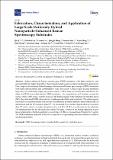Fabrication, characterization, and application of large-scale uniformly hybrid nanoparticle-enhanced Raman spectroscopy substrates
Author(s)
Qi, Q; Liu, C; Liu, L; Meng, Q; Wei, S; Ming, A; Zhang, J; Wang, Y; Wu, L; Zhu, X; Wei, F; Yan, J; ... Show more Show less
DownloadPublished version (3.082Mb)
Terms of use
Metadata
Show full item recordAbstract
© 2019 by the authors. Surface-enhanced Raman spectroscopy (SERS) substrates with high sensitivity and reproducibility are highly desirable for high precision and even molecular-level detection applications. Here, large-scale uniformly hybrid nanoparticle-enhanced Raman spectroscopy (NERS) substrates with high reproducibility and controllability were developed. Using oxygen plasma treatment, large-area and uniformly rough polystyrene sphere (URPS) arrays in conjunction with 20 nm Au films (AuURPS) were fabricated for SERS substrates. Au nanoparticles and clusters covered the surface of the URPS arrays, and this increased the Raman signal. In the detection of malachite green (MG), the fabricated NERS substrates have high reproducibility and sensitivity. The enhancement factor (EF) of Au nanoparticles and clusters was simulated by finite-difference time-domain (FDTD) simulations and the EF was more than 104. The measured EF of our developed substrate was more than 108 with a relative standard deviation as low as 6.64%-13.84% over 15 points on the substrate. The minimum limit for the MG molecules reached 50 ng/mL. Moreover, the Raman signal had a good linear relationship with the logarithmic concentration of MG, as it ranged from 50 ng/mL to 5 μg/mL. The NERS substrates proposed in this work may serve as a promising detection scheme in chemical and biological fields.
Date issued
2019-05-01Department
Massachusetts Institute of Technology. Department of ChemistryJournal
Micromachines
Publisher
MDPI AG